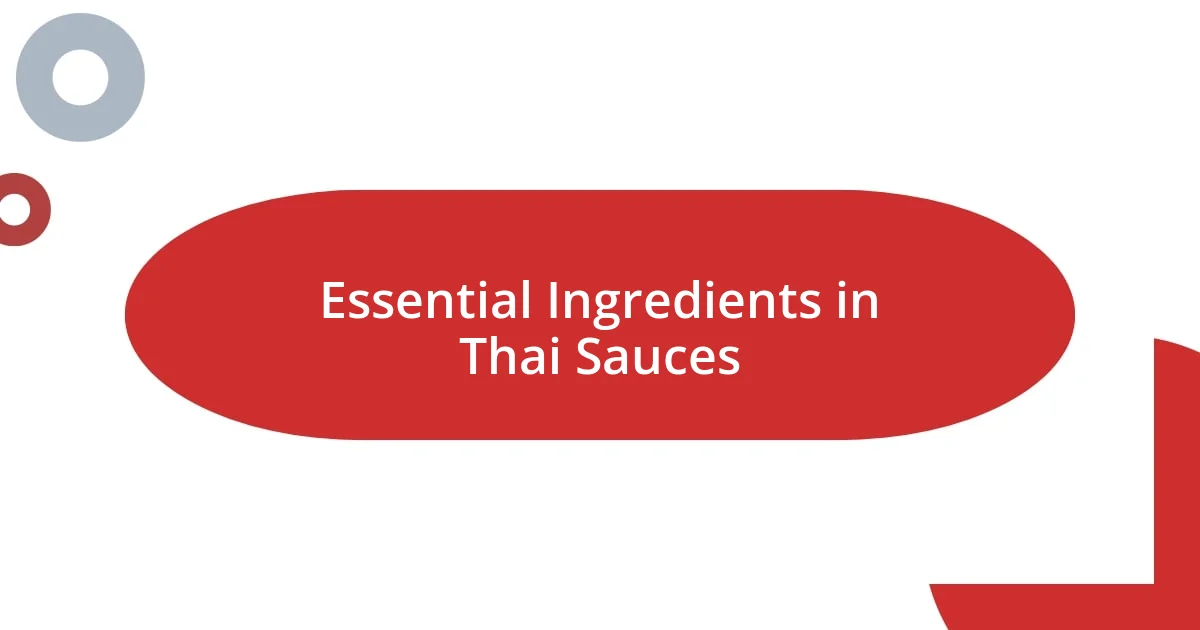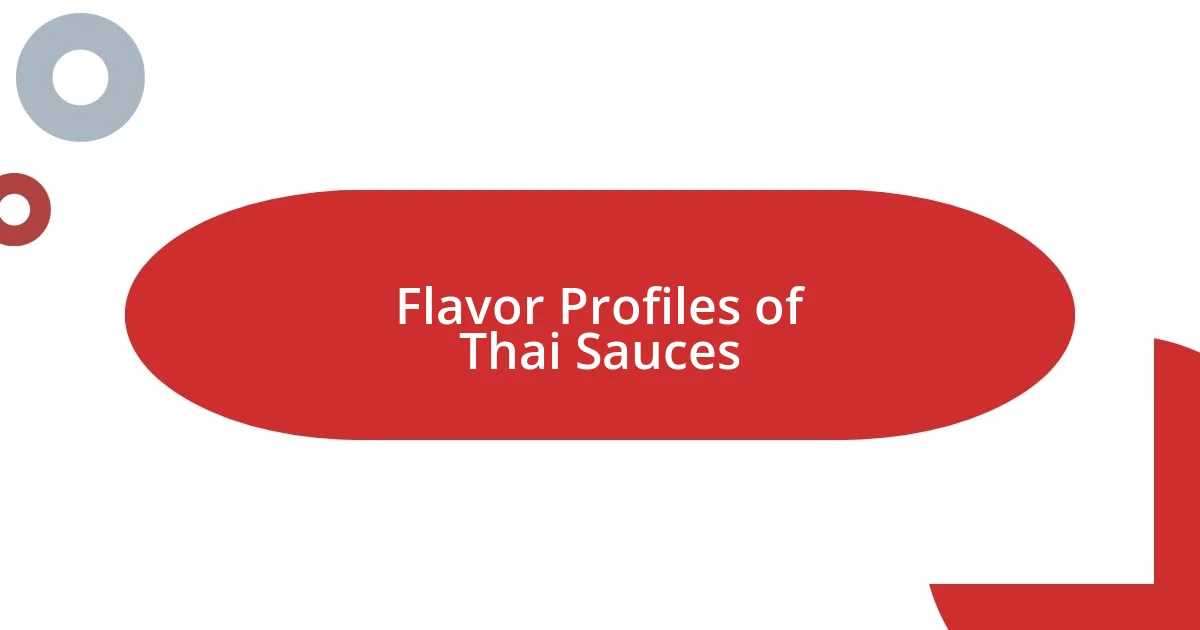Key takeaways:
- Thai sauces embody a rich blend of flavors—sweet, salty, sour, and spicy—enhancing dishes and reflecting the country’s culinary heritage.
- Key ingredients in Thai sauces include coconut milk, fish sauce (nam pla), and chili peppers, each contributing distinct flavor profiles to various dishes.
- Homemade Thai sauces allow for creative experimentation, emphasizing the importance of balance and personal connection to the culture through cooking.

Overview of Thai Sauces
Thai sauces are a vibrant and essential component of Thai cuisine, reflecting the country’s rich culinary heritage. With a beautifully balanced blend of flavors—sweet, salty, sour, and spicy—these sauces not only enhance dishes but also tell a story of the unique ingredients and traditions behind them. I often find myself reminiscing about the first time I dipped fresh spring rolls into a tangy tamarind sauce; the explosion of flavors was unlike anything I’d experienced before.
One of my favorite aspects of Thai sauces is their versatility. Just think about it: you can elevate a simple grilled chicken dish with a drizzle of spicy sriracha or match a delicate fish with a light, fragrant nam pla (fish sauce). Each sauce has its own personality, and I love experimenting with them in my cooking, creating new combinations that surprise my palate. Can you feel the excitement when a new flavor sparks inspiration in your kitchen?
From the creamy richness of peanut sauce to the addictive kick of chili paste, the variety is endless. It’s fascinating how each region in Thailand boasts its own signature sauces, often defined by local ingredients. I remember visiting a market in Thailand and being mesmerized by the colorful array of sauces. The experience was not just about food; it was a celebration of culture, passion, and a reminder of how food can connect us.

Essential Ingredients in Thai Sauces
When I think of essential ingredients in Thai sauces, a few key components come to mind. Coconut milk, for instance, brings a creamy richness that elevates many dishes, while fresh herbs like cilantro and basil add a vibrant touch. I remember whipping up a coconut curry at home; the moment the fragrant basil hit the pot, the aroma filled my kitchen and instantly transported me to Thailand.
Another significant ingredient is fish sauce, or nam pla. This salty, umami-rich sauce is often the backbone of many Thai recipes. I once had a cooking class where we made a classic green papaya salad, and the teacher emphasized the importance of using high-quality fish sauce. The flavors that emerged were layered and complex, something I don’t think I would have grasped without that hands-on experience.
Lastly, let’s not forget the crucial role of chili peppers. They don’t just add heat; they create excitement in each bite. I find it interesting how different regions use various types of chilies to achieve unique flavor profiles. Fun fact: some of my most memorable meals have included sauces with a perfect balance of heat and sweetness, encouraging me to embrace both the kick and the comforting flavors of Thai cuisine.
| Ingredient | Flavor Profile |
|---|---|
| Coconut Milk | Creamy, sweet |
| Fish Sauce (Nam Pla) | Salty, umami |
| Chili Peppers | Spicy, vibrant |

Popular Types of Thai Sauces
Thai cuisine is replete with various sauces, each offering a distinct taste that contributes to the overall experience of a meal. In my culinary adventures, I’ve encountered several standout sauces that have transformed my dishes from ordinary to extraordinary. For instance, dipping crispy fresh spring rolls into sweet chili sauce instantly brings a burst of joy. It’s this interplay of sweetness and spice that continuously inspires me to experiment in the kitchen.
Here’s a quick list of some popular Thai sauces:
- Sriracha: A spicy chili sauce that adds heat to just about any dish.
- Nam Pla: This fish sauce delivers a savory umami kick essential for authentic flavor.
- Peanut Sauce: Creamy and slightly sweet, perfect for pairing with salads or grilled meats.
- Sweet Chili Sauce: A delightful combination of sweetness and spice, often used as a dip.
- Tamarind Sauce: Tangy and slightly sour, it provides a refreshing contrast in many dishes.
In my experience, the right sauce can evoke strong emotions and transport you back to specific moments. I vividly recall savoring a rich curry while visiting a temple in Thailand, the rain gently falling outside. The flavor of the curry sauce mingled with the scents of the market, creating a memory that’s forever etched in my mind. Each time I cook a Thai dish, I find myself chasing that same feeling, striving to recreate the sense of warmth and community that good food brings.

Flavor Profiles of Thai Sauces
When diving into the flavor profiles of Thai sauces, I can’t help but think of how balance plays such a critical role. Take for instance, the harmony achieved in a classic Pad Thai sauce, where tamarind’s tangy sweetness is perfectly poised against the saltiness of fish sauce. It reminds me of a lovely street food stall in Bangkok where I first discovered how each element in the sauce danced together, creating a memorable experience. Isn’t it fascinating how a simple blend can evoke such complex emotions?
Another sauce that embodies this balance is the peanut sauce, often featured in satays or salads. Its creaminess paired with a slight sweetness warmly envelops the other flavors on your plate, making it a comforting choice. I remember how I first experimented with this sauce at a family gathering, pairing it with grilled chicken skewers. The moment everyone took that first bite and smiled, I knew I had hit the mark. That moment truly encapsulates how a sauce can elevate a dish into something unforgettable.
And let’s not overlook the fiery chili pastes that can vary greatly across regions. The boldness of a som tam (green papaya salad) dressed with chili paste adds an exhilarating kick that can make your taste buds dance. I once attended a Thai cooking workshop that had us mix a variety of chili pastes, and the instructor was right: finding the right heat level is essential. Who knew that the right amount of spice could stir such excitement and joy in a meal? That’s the beauty of these sauces; they invite us to embrace and explore flavors that connect us to a culture steeped in rich culinary traditions.

Pairing Thai Sauces with Dishes
When it comes to pairing Thai sauces with dishes, I often find myself thinking about the incredible versatility they offer. For instance, I love drizzling peanut sauce over fresh summer rolls; the creaminess contrasts beautifully with the crisp veggies. Each bite transports me back to a sunny afternoon spent at a bustling Thai market, where the flavors came alive.
One of my favorite combinations is sweet chili sauce with fried chicken. When I experienced this pairing for the first time, it felt like an explosion of flavor in my mouth. The sweetness cuts through the savory, crispy exterior of the chicken, creating a delightful balance that kept me going back for more. Have you ever tried it? The memory of that bite still makes my stomach happy, and I can’t resist recreating it at home.
And let’s not forget about the wonders of Nam Pla. I love using it to enhance a simple vegetable stir-fry, where its umami notes elevate the dish unexpectedly. I remember the excitement of introducing this sauce to my friends during a dinner party. The difference it made was palpable, sparking conversations about the flavors and aromas. It struck me then how one sauce could turn an ordinary meal into an experience that lingers long after the last bite.

Making Homemade Thai Sauces
When making homemade Thai sauces, I often find it rewarding to experiment with ingredients that I already have in my pantry. The first time I attempted to create a classic sweet chili sauce, I used leftover chili flakes and a bit of sugar. I was amazed at how a quick simmer transformed those simple ingredients into something so flavorful. Have you ever had that moment of surprise when you realize your kitchen can yield something truly delicious?
Balancing flavors is essential in homemade Thai sauces. I remember trying my hand at a green curry paste, blending fresh herbs like cilantro and basil with garlic and a hint of lime juice. The aroma wafting through my kitchen was intoxicating! It hit me then that the act of creating something from scratch connects you to the culture in a way that store-bought sauces simply can’t. Doesn’t it feel satisfying to know exactly what’s in your food?
Finding the right consistency for sauces can be a fun challenge. The first time I tried making a thick, rich peanut sauce, it ended up too watery. After adjustments—using roasted peanuts and a touch of coconut milk—I finally achieved that creamy texture I was after. Each dip of a fresh veggie into that sauce now carries a bit of my journey toward mastering it. It’s incredible how making your own sauces can turn a simple meal into something that feels like a grand celebration of flavors.















